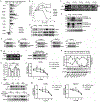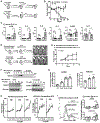A Benzenesulfonamide-Based Mitochondrial Uncoupler Induces Endoplasmic Reticulum Stress and Immunogenic Cell Death in Epithelial Ovarian Cancer
- PMID: 34625503
- PMCID: PMC8643344
- DOI: 10.1158/1535-7163.MCT-21-0396
A Benzenesulfonamide-Based Mitochondrial Uncoupler Induces Endoplasmic Reticulum Stress and Immunogenic Cell Death in Epithelial Ovarian Cancer
Abstract
Epithelial ovarian cancer (EOC) is the leading cause of death from gynecologic malignancies and requires new therapeutic strategies to improve clinical outcomes. EOC metastasizes in the abdominal cavity through dissemination in the peritoneal fluid and ascites, efficiently adapt to the nutrient-deprived microenvironment, and resist current chemotherapeutic agents. Accumulating evidence suggests that mitochondrial oxidative phosphorylation is critical for the adaptation of EOC cells to this otherwise hostile microenvironment. Although chemical mitochondrial uncouplers can impair mitochondrial functions and thereby target multiple, essential pathways for cancer cell proliferation, traditional mitochondria uncouplers often cause toxicity that precludes their clinical application. In this study, we demonstrated that a mitochondrial uncoupler, specifically 2,5-dichloro-N-(4-nitronaphthalen-1-yl)benzenesulfonamide, hereinafter named Y3, was an antineoplastic agent in ovarian cancer models. Y3 treatment activated AMP-activated protein kinase and resulted in the activation of endoplasmic reticulum stress sensors as well as growth inhibition and apoptosis in ovarian cancer cells in vitro Y3 was well tolerated in vivo and effectively suppressed tumor progression in three mouse models of EOC, and Y3 also induced immunogenic cell death of cancer cells that involved the release of damage-associated molecular patterns and the activation of antitumor adaptive immune responses. These findings suggest that mitochondrial uncouplers hold promise in developing new anticancer therapies that delay tumor progression and protect patients with ovarian cancer against relapse.
©2021 American Association for Cancer Research.
Conflict of interest statement
Competing interests
The authors declare no potential conflicts of interest.
Figures






Similar articles
-
Morusin induces paraptosis-like cell death through mitochondrial calcium overload and dysfunction in epithelial ovarian cancer.Chem Biol Interact. 2018 Mar 1;283:59-74. doi: 10.1016/j.cbi.2018.02.003. Epub 2018 Feb 5. Chem Biol Interact. 2018. PMID: 29421517
-
Low glucose and metformin-induced apoptosis of human ovarian cancer cells is connected to ASK1 via mitochondrial and endoplasmic reticulum stress-associated pathways.J Exp Clin Cancer Res. 2019 Feb 13;38(1):77. doi: 10.1186/s13046-019-1090-6. J Exp Clin Cancer Res. 2019. PMID: 30760281 Free PMC article.
-
Angiotensin II promotes ovarian cancer spheroid formation and metastasis by upregulation of lipid desaturation and suppression of endoplasmic reticulum stress.J Exp Clin Cancer Res. 2019 Mar 7;38(1):116. doi: 10.1186/s13046-019-1127-x. J Exp Clin Cancer Res. 2019. PMID: 30845964 Free PMC article.
-
Plant-derived natural compounds: A new frontier in inducing immunogenic cell death for cancer treatment.Biomed Pharmacother. 2024 Aug;177:117099. doi: 10.1016/j.biopha.2024.117099. Epub 2024 Jul 8. Biomed Pharmacother. 2024. PMID: 38981240 Review.
-
Stress-induced cellular responses in immunogenic cell death: Implications for cancer immunotherapy.Biochem Pharmacol. 2018 Jul;153:12-23. doi: 10.1016/j.bcp.2018.02.006. Epub 2018 Feb 10. Biochem Pharmacol. 2018. PMID: 29438676 Review.
Cited by
-
Endoplasmic Reticulum Stress-Related Ten-Biomarker Risk Classifier for Survival Evaluation in Epithelial Ovarian Cancer and TRPM2: A Potential Therapeutic Target of Ovarian Cancer.Int J Mol Sci. 2023 Sep 12;24(18):14010. doi: 10.3390/ijms241814010. Int J Mol Sci. 2023. PMID: 37762313 Free PMC article.
-
The role of the inflammasome and its related pathways in ovarian cancer.Clin Transl Oncol. 2022 Aug;24(8):1470-1477. doi: 10.1007/s12094-022-02805-y. Epub 2022 Mar 14. Clin Transl Oncol. 2022. PMID: 35288840 Review.
-
NRF2 controls iron homeostasis and ferroptosis through HERC2 and VAMP8.Sci Adv. 2023 Feb 3;9(5):eade9585. doi: 10.1126/sciadv.ade9585. Epub 2023 Feb 1. Sci Adv. 2023. PMID: 36724221 Free PMC article.
-
Targeting endoplasmic reticulum stress signaling in ovarian cancer therapy.Cancer Biol Med. 2023 Oct 10;20(10):748-64. doi: 10.20892/j.issn.2095-3941.2023.0232. Cancer Biol Med. 2023. PMID: 37817482 Free PMC article. Review.
-
Research progress in inducing immunogenic cell death of tumor cells.Front Immunol. 2022 Nov 17;13:1017400. doi: 10.3389/fimmu.2022.1017400. eCollection 2022. Front Immunol. 2022. PMID: 36466838 Free PMC article. Review.
References
-
- Matulonis UA, Shapira-Frommer R, Santin AD, Lisyanskaya AS, Pignata S, Vergote I, et al. Antitumor activity and safety of pembrolizumab in patients with advanced recurrent ovarian cancer: results from the phase II KEYNOTE-100 study. Ann Oncol 2019;30(7):1080–7 doi 10.1093/annonc/mdz135. - DOI - PubMed
Publication types
MeSH terms
Substances
Grants and funding
LinkOut - more resources
Full Text Sources
Research Materials

